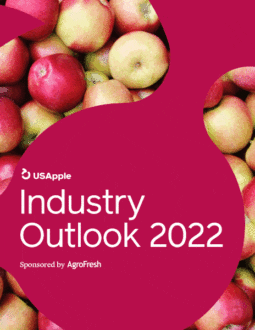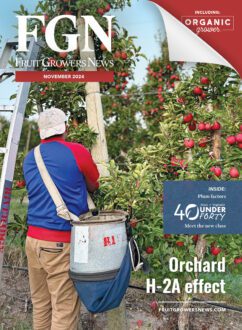Aug 18, 2022Apple association forecasts higher U.S. production in 2022-23
Total U.S. apple production for the 2022-23 fiscal year is forecast to be more than 255 million bushels or 10.7 billion pounds.
The predicted volume represents a 2.7% increase compared to last year’s production and is 3.5% smaller than the five-year production average of apples for the fresh and processing markets, according to a USApple analysis of U.S. Department of Agriculture data.
Production is predicted to increase in New York, Michigan, California, Virginia and Oregon while output is slated to decline in Washington and Pennsylvania.
For Washington, the leading U.S. apple growing state, production is expected to decline 4% year-over-year, from 160.9 million bushels in 2021-22 to 154.7 million bushels in 2022-23.
 New York volume is projected to expand 8% from 31.9 million bushels in 2021-22 to 34.5 million bushels.
New York volume is projected to expand 8% from 31.9 million bushels in 2021-22 to 34.5 million bushels.
Booming Michigan
The biggest volume gainer is Michigan, where production is pegged to increase 68% from the previous year’s 15.6 million bushels to 26.1 million bushels in 2022-23. An April 2021 freeze caused production to plummet.
Pennsylvania’s crop is anticipated to drop 17%, from 13.2 million bushels last fall to 10.9 million bushels. California volume is eyed to increase from 5.1 million bushels to 5.7 million bushels. Virginia is looking at a 12.8% increase from 3.9 million bushels to 4.1 million bushels. The apple association is projecting Oregon will increase production 12.5% from 3.7 million bushels to 4.1 million bushels.
Chris Gerlach, USApple’s director of industry analytics, wrote the report and noted that the association’s figures are more comprehensive than USDA data, which only reviews the top seven apple producing states. The USDA released its estimate Aug. 12.
“We’ve analyzed the production from states outside of the top seven and added that back to USDA’s figure,” Gerlach said in a news release.
Variety jumps
Galas, which first surpassed Red Delicious production in the 2018-19 season, continue to be the top variety with 18%, or almost 46 million bushels, of U.S. apple production. That’s followed by Red Delicious at 34 million bushels, Fujis at 26 million bushels, Honeycrisps at 25 million bushels, and Granny Smiths at 24 million bushels.
In general, managed varieties/club apples are increasing in volume, including Honeycrisp, Pink Lady/Cripps Pink and Cosmic Crisp. Fuji, Granny Smith and Rome varieties have remained relatively consistent compared to 2017-18 production volumes. Declining varieties include Golden Delicious, Galas and Red Delicious, according to the release.
Honeycrisp production increased by 48% (8 million bushels) in the past five years, Gerlach said in the release. Conversely, Red Delicious decreased by 41% (24 million bushels) during the same period.
In international apple trade, the U.S. retains a healthy positive trade balance, according to the release. In 2021-22, the U.S. exported more than 38.5 million bushels of fresh apples while importing about 6.3 million bushels. The 32.2 million bushels net exports are valued at almost $730 million.
“Despite the challenges of the past two-and-a-half years, the U.S. apple industry is alive and well in 2022,” USApple said in the release.
New industry tool
USApple also unveiled an industry database and dashboard that provides a one-stop-shop for apple-related statistics.
The Newton Database & Dashboard provides information including annual production to monthly storage numbers. Several years in the making, Newton gives users the ability to view preset reports or create custom queries to download. Newton’s dashboard also keeps users up to date on the latest trends in apple prices and trade.
“We are extremely excited to launch this unique USApple member benefit,” Gerlach said in the release.
Newton consolidates data from USApple and multiple USDA sources, giving users updated information on apple production, utilization, trade, prices, storage, movement, economic impacts and more. For more information, visit USApple.org.
The information was released by the U.S. Apple Association on Aug. 18, the first of its two-day annual Outlook Conference in Chicago.
—Doug Ohlemeier, assistant editor















